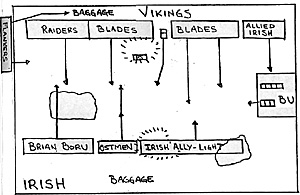On the occasion of this special day, our regular weekly meeting played a pseudo-Clontarf team game with 400 points each. This game had it all -- in addition to historical opponents, we saw an off board flank march, three unreliable allies (one of which ultimately changed ddesl) and the loss of baggage.
The Norse Irish were defending with four large commands. On their far right was Clontarf with an ambush of auxilia. In the same command and to the left of the BUA were two lines of auxilia with superior in front and ondina two inches behind. They occupied a rough area and a gentle hill.
Next to the left were 16 stands of allied Ostmen (ordinary blades) in a double line of eight. On the far left was Brian Boru with a mixed bag of psiloi, auxilia and two warbands. Munchads command was on a flank march on the Irish left, another mixed unit of light infantry.
The Vikings had a gentle hill just in front of Uheir deployment area which hid four stands of inferior Irish psiloi placed to disrupt the Viking advance. On the Viking left was an allied command of all Irish light troops facing the BUA. Two classic Viking commands of ordinary and inferior blades held the right/center and the left/center in deep formation seperated by two lone stands of fast warbands. On the far right were Viking Raiders- fast blades and huscarles and two stands of cavalry.
The Vikings smelled a trap as they moved forward, there were not enough Irish in sight for 400 points. Their Irish ally proved unreliable but moved forward anyway to clear Clontarf, they stopped upon seeing the ambush at 50 paces. To their right, the Vikings advanced with caution, waiting for their allies to roll a six.
In the right/center, the Vikings rolled over the ambushing psiloi, resolving the unreliability of the Irish right wing. Raiders rushed ahead, looking for Brian. On the Irish right, they were first unreliable and then cautious, not anxious to match auxilia versus blades and also waiting for the flank march. The Ostmen were also unreliable and were pinned early. Brian moved boldly forward with the expectation of the surprise arrival of Manchad.
This expectation was fulfilled with a six on tum four, Munchad plowed into the unprepared Raiders on turn five. The battle was ultimately decided here. The Raider cavalry and two far right stands fled in panic but regrouped to stem the penetration. Half of the Rankers went after the baggage, eventually taking two stands after initially being repulsed. To the front, Viking blades were pushing back Irish superior auxilia. Both sides were suffering heavy casualties.
Ths Ostmen finally came up to support Brian's right as Norse blades clashed nose to nose. Closer to Clontarf, action was limited. The Viking allies were still unreliabie and the neighboring Vikings were concerned for their flanks. The opposing Irish were content to wait.
The game ended suddenly as the Viking Raiders finally broke under the flanking onslaught (Briars command was only two stands away from a similar disaster) The still unreliable allies changed sides and the rest of the Vikings ran for Dublin.
As noted above, the battlt demonstrated several seldom seen aspects of DBM. The deciding factor, however was the command dice: the allies were all unreliable, only one of whom recovered with a six; also the flank march came in reasonable time - also with a six. If the sixes had been reversed so that the Vikings allies could have cleared Clontarf and the Murchad had not arrived, the Vikings would have won big. But such are the fortunes of war DBM style and the luck of the Irish on St. Patricks Day!

Back to Saga #49 Table of Contents
Back to Saga List of Issues
Back to MagWeb Master Magazine List
© Copyright 1995 by Terry Gore
This article appears in MagWeb (Magazine Web) on the Internet World Wide Web. Other military history articles and gaming articles are available at http://www.magweb.com